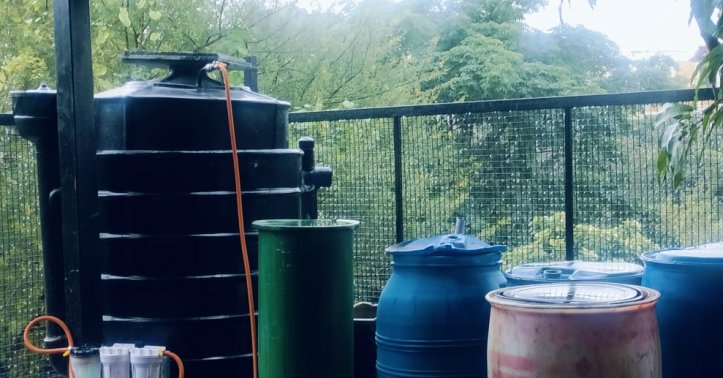
Glimpse of Climate Action and Environmental Sustainability at Our Rural Home
As I look back on the last decade of my life, the story of climate action at my rural home on the outskirts of Bangalore stands out like a bright lamp at the end of a dark tunnel, a journey marked by struggle, disappointment, renewed hope, and eventual success. The image above is a simple but powerful glimpse into this evolving narrative, the physical embodiment of environmental sustainability built not from abundance, but from the persistent absence of basic civic services and the necessity to act where no one else would.
Living in a rural residential layout in a village under the BMRDA jurisdiction, surrounded by valleys, hills, and forest, life should have carried the promise of abundance and peace. Instead, it posed a daily reality of uncollected waste, a silent yet pressing challenge left ignored by local authorities and the RDPR system. Garbage collection, a service so basic that it is taken for granted elsewhere, simply did not exist for us. This void could have bred resentment or resignation, but for me, it became an invitation, an urgent call to explore and build sustainable living practices in the absence of any external support system.
Resilience through Biogas and Composting
So, necessity became the mother of invention. Central to our climate action approach is a small biogas plant, quietly converting organic waste each day into clean energy. There is a distinct joy in witnessing food scraps, vegetable peels, and garden residues dissolve into high-quality biogas slurry, a process that not only reduces my reliance on fossil fuels but also minimizes our household's greenhouse gas emissions. It is humbling to realize how much potential lies in what we usually dismiss as “waste.” Each time I harvest this energy, I know I am closing the distance between problem and possibility.
Running hand in hand with the biogas system is our home composting setup. Every bit of kitchen and garden waste that would otherwise feed a landfill becomes a source of rich, natural nourishment for our soil. Through careful layering, turning, and patient observation, the compost matures week after week, quietly transforming into black gold. It is this material, teeming with nutrients and life that feeds our fruit trees, flowers, and revives the old lawn that has witnessed my family's many seasons of experiment and learning.
Just as nature will not tolerate emptiness for long, our household learned not to tolerate waste. Instead, by “closing the loop” in waste management, we turned old routines on their head, where disposal turned to production, neglect to nourishment.
Living Beyond the City’s Noise
Living far from the hustle and bustle of the city imparts its own lessons. The proximity to valleys and the surrounding forest has fostered not just isolation, but resilience and deep connection. Here, biodiversity is not an abstract concept discussed in conferences; it is something I witness, nurture, and feed every day. The compost and slurry continually transform our patch of land into a thriving oasis, fruit trees bloom, native plants thrive, and the seasonal calls of wild birds remind me that stewardship, not consumption, is the true essence of sustainability.
But, what has this struggle taught me about climate action itself? When did it truly begin? Was it born of grand inspiration, or, rather, shaped by necessity’s hard edge? For us, the answer is plain—daily reality left little room for choice. With official agencies absent, and layouts left without even basic waste services, who else could bear the burden but the residents themselves? What began as compulsion has become the bedrock of renewal. Week after week, I watched kitchen scraps and garden litter transform into high-quality biogas slurry and compost, nourishing our landscape in the most elementary, yet profound, way.
Rethinking Climate Dialogues and Governance
This experience prompts me to question narratives prevailing in the world outside—those scripted in five-star hotels, UN summits, or WEF global assemblies. What might those who debate climate action surrounded by policy papers and diplomatic etiquette see if they stood in my muddy backyard, hands deep in compost, clothing soiled and heart hopeful? Would they find, in this hands-on model, a truer reflection of the struggles and achievements marking real climate action? Would they recognize how grassroots innovations, born of necessity and driven by citizen agency, have the power not just to manage waste, but to foster genuine resilience and self-sufficiency?
Perhaps policymaking and international forums have their place, but they have failed to resolve chronic waste management issues at the grassroots. In their absence, ordinary people have become the change-makers. Necessity liberated creativity and compelled the birth of tangible, bottom-up solutions.
Lessons from a Decade: Hope Beyond the Dark Tunnel
Looking back, I see a journey that was anything but easy. There were days marked by failure, systems that did not work, compost that refused to mature, biogas plants that fell silent, and a lonely sense of abandonment confronting the lack of basic essential services. Yet, every setback tested and refined my resolve, leading me through experimentation, learning, and innovation. The critical lesson was clear: lack of government support, while challenging, served as fertile ground to explore and uncover new paths in sustainable living.
Each barrel and tank in the photograph represents more than infrastructure; it embodies a decade of struggle and triumph, a story of agency reclaimed. Today, my home stands as a glowing example of circular living—a model shaped by necessity's hard edge but illuminated by the promise of self-driven transformation. The biodiversity that flourishes here is not just the product of good fortune, but of daily intention and resilience.
The Bigger Question: Citizen-Led Action and Participatory Governance
What if everyone facing a similar absence of support could be empowered to take action? What would participatory governance look like if it recognized, supported, and scaled such efforts—enabling citizens with tools, guidance, and trust? Could we usher in a new era where climate action germinates not in boardrooms, but in homes, community gardens, and local landscapes?
At the end of a long tunnel of struggle, a bright light beckons. It is the vision of every household becoming a laboratory for ecological restoration, every citizen a steward, and every act of necessity transmuted into resilience and hope. For our home and many like it, true sustainability flourishes not because of government intervention, but sometimes in spite of its absence. The struggle continues, but so too does learning, adaptation, and the unwavering belief that real climate action belongs in the hands of those who live with the consequences, every single day.
By Pritam Kumar Sinha








